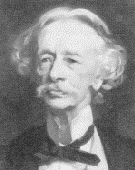Coventry Patmore believed his wife Emily was the perfect Victorian wife
and wrote "The Angel in the House" about her (originally published in 1854, revised through 1862). Though it did not receive much attention
when it was first published in 1854, it became increasingly popular through the rest of
the nineteenth century and continued to be influential into the twentieth century. For Virginia
Woolf, the repressive ideal of women represented by the Angel in the House was still so potent that she wrote, in 1931,
"Killing the Angel in the House was part of the occupation of a woman writer."
The following excerpt will give you a sense of the ideal woman and the male-female relationship
presented by Patmore's poem:
Man must be pleased; but him to please
Is woman's pleasure; down the gulf
Of his condoled necessities
She casts her best, she flings herself.
How often flings for nought, and yokes
Her heart to an icicle or whim,
Whose each impatient word provokes
Another, not from her, but him;
While she, too gentle even to force
His penitence by kind replies,
Waits by, expecting his remorse,
With pardon in her pitying eyes;
And if he once, by shame oppress'd,
A comfortable word confers,
She leans and weeps against his breast,
And seems to think the sin was hers;
Or any eye to see her charms,
At any time, she's still his wife,
Dearly devoted to his arms;
She loves with love that cannot tire;
And when, ah woe, she loves alone,
Through passionate duty love springs higher,
As grass grows taller round a stone.
Initially this ideal primarily expressed the values of the middle classes. However, with Queen Victoria's marriage
to Prince Albert and her devoting herself to a domestic life, the ideal spread throughout
nineteenth century society.
|



